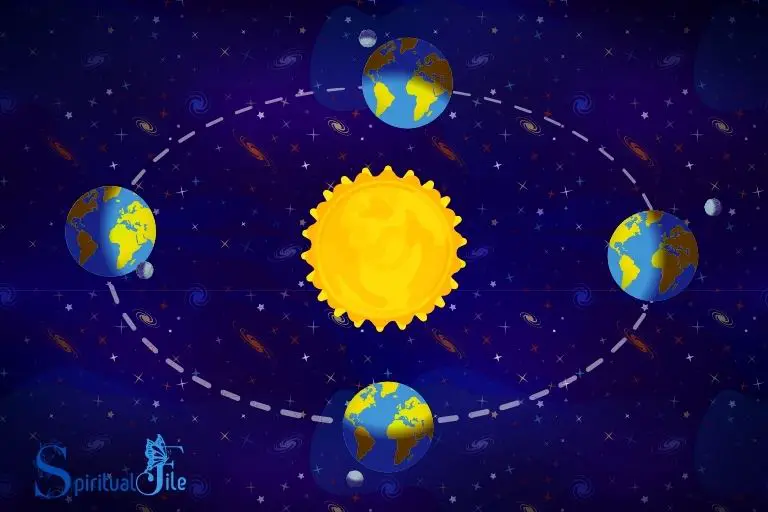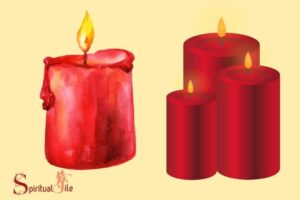What Does Winter Solstice Represent Spiritually? Rebirth!
The winter solstice spiritually represents a time of introspection, rebirth, and renewal, as it marks the shortest day and longest night of the year when the Earth’s tilt is farthest from the Sun.
Occurring around December 21st in the Northern Hemisphere and June 21st in the Southern Hemisphere, it is a time when darkness prevails, and daylight hours are minimal.
This period of darkness and cold has been associated with various symbolic and spiritual meanings, often focusing on themes of inner growth, self-reflection, and the birth of new possibilities.

Key Takeaway
7 Spiritual Significances of winter solstice
| Spiritual Significance | Description |
|---|---|
| Rebirth and Renewal | Symbolizes personal or spiritual renewal, embracing new beginnings. |
| Balance and Harmony | Represents the equilibrium between light and darkness, reminding us to find harmony within ourselves and the world. |
| Inner Reflection | Encourages introspection and self-examination during the darker months. |
| Letting Go | A time to release negative habits, emotions, or attachments, making space for positive growth. |
| Festival of Light | Celebrated with lights, candles, or bonfires to signify the triumph of light over darkness and knowledge over ignorance. |
| Connection to Nature | Emphasizes our connection to the natural world and our gratitude for its cycles. |
| Community and Unity | Historically a time for communities to come together, highlighting the importance of supporting and connecting with others. |
Understanding Winter Solstice
Defining The Winter Solstice
The winter solstice is an astronomical event that occurs annually between december 20th and december 23rd in the northern hemisphere.
It is the shortest day and the longest night of the year. In the southern hemisphere, the winter solstice occurs on the opposite date and marks the longest day and shortest night of the year.
The Astronomy Of Winter Solstice
Winter solstice marks the point when the sun is at its lowest point in the sky and the tilt of the earth’s axis is farthest from the sun.
After this day, the sun appears to gradually rise higher in the sky, and the days gradually become longer until the summer solstice.
The History Of Winter Solstice Celebrations
The winter solstice has been a spiritual event celebrated by cultures worldwide. Ancient civilizations like the Mayans and Egyptians built astronomical structures to observe it.
Today, it’s a time for reflection, setting intentions, and symbolizes rebirth as the days grow longer and the sun shines brighter.
Today, many people celebrate winter solstice as a time of spiritual connection, meditation, and introspection.
Winter solstice is a significant astronomical event that marks the shortest day and longest night of the year. Its history as a spiritual event is celebrated by various cultures, and it represents a time of new beginnings and renewed spiritual connections.
Winter Solstice In Different Cultures
Winter solstice is a significant celestial event that occurs every year on december 21st or 22nd in the northern hemisphere.
This moment marks the shortest day and the longest night of the year. It’s a time of year that has always been regarded spiritually and celebrated in various cultures worldwide.
Winter Solstice In Pagan Traditions
- Winter solstice is known as yule in pagan traditions.
- Pagans celebrate the return of the sun as the days start to get longer after this day.
- The winter solstice is celebrated as a time of rebirth and renewal in paganism.
- Pagans include a bonfire in their celebrations and practice rituals imbibed with merry and joy.
- The yule log is an essential part of the celebration that represents warmth and protection from evil.
Winter Solstice In Christian Traditions
- Christmas, the most famous christian holiday, is believed to be a transformed version of winter solstice celebrations.
- Christians celebrate the birth of jesus christ, whom they believe is the light of the world, a symbol of renewal, and the ultimate redeemer.
- Christmas celebrations include lighting candles, decorating christmas trees, and exchanging gifts, symbolizing the hope and light that christ’s birth brings to humanity.
Winter Solstice In Ancient Roman Traditions
- The romans observed winter solstice with a festival called saturnalia, which lasted for a week.
- During saturnalia, people exchanged gifts, decorated their homes with greenery, and feasted for days.
- The festival culminated in the “dies natalis solis invicti” or the “birthday of the unconquerable sun,” celebrating the renewal of the sun’s cycle.
- Saturnalia inspired many of the traditions that are now part of modern christmas celebrations, such as gift-giving and decorating homes with greenery.
Various cultures worldwide celebrate winter solstice with their unique traditions, all of which signify the significance of renewal, hope, and the return of light after a period of darkness.
Regardless of the traditions, winter solstice is a time for rekindling the spirit, celebrating the past, and anticipating the future.
The Spiritual Meaning And Symbolism Of Winter Solstice
Winter solstice, also known as the shortest day of the year, is a significant day for many cultures worldwide. Spiritually, it represents a time of renewal, hope, and an opportunity to embrace the darkness and light within ourselves.
Let’s explore the spiritual meaning and symbolism of winter solstice while discussing its significance in different aspects of life.
The Significance Of Darkness And Light
The winter solstice signifies the balance between darkness and light. It reminds us that life is a never-ending cycle of both positivity and negativity.
It represents a time of introspection, letting go of what no longer serves us, and embracing the unknown.
Key Points:
- Winter solstice is a reminder that darkness and light are equally important.
- Embracing darkness allows us to recognize our imperfections and move forward.
- Light symbolizes hope and positivity, a new beginning, and a fresh start.
The Rebirth Of The Sun
In many cultures, winter solstice marks the rebirth of the sun. The days gradually become longer, and the sun shines brighter.
It’s a time of hope and healing, a time to renew our spirit and connect with the universe’s energy.
Key Features:
- Winter solstice signifies the return of the light, both literally and metaphorically.
- It offers an opportunity to release old patterns, thoughts, and behaviors that no longer serve our highest good.
- Rebirth symbolizes growth, renewal, and starting anew.
The Cycles Of Life And Death
Winter solstice also represents the cycle of life and death. It’s a time to acknowledge that everything in life has a beginning, middle, and end. It reminds us to cherish each moment and embrace both the good and the bad.
Key Features:
- Winter solstice represents the circle of life, death, and rebirth.
- It encourages us to embrace change and the unknown.
- It reminds us to celebrate life and cherish every moment we have.
As we celebrate winter solstice, let’s take a moment to reflect on the past year and the lessons we’ve learned.
May we embrace darkness and light, release what no longer serves us, and look forward to a brighter tomorrow. Remember, winter solstice is not just a physical phenomenon; it’s also a spiritual awakening.
How Does the Spiritual Symbolism of Renewal in the Ocean Compare to the Symbolism of Rebirth in Winter Solstice?
The spiritual representation of the ocean is often associated with renewal and rebirth. Just as the waves continually cleanse the shore, the ocean symbolizes a fresh start and transformation. Similarly, the symbolism of rebirth in winter solstice represents a new beginning and growth after a period of darkness.
FAQ About What Does Winter Solstice Represent Spiritually?
What Is Winter Solstice Spiritually?
Winter solstice spiritually marks the longest night, the return of light, and hope.
What Is The Spiritual Significance Of The Winter Solstice?
The winter solstice represents a time of death and rebirth, new beginnings, and transformation.
How Do People Celebrate The Winter Solstice Spiritually?
People celebrate the winter solstice spiritually by performing rituals, lighting candles, and gathering with loved ones.
Why Is The Winter Solstice Important Spiritually?
The winter solstice is important spiritually because it symbolizes a time of reflection, renewal, and spiritual growth.
How Can The Winter Solstice Be Used For Spiritual Growth?
The winter solstice can be used for spiritual growth by reflecting on the past year, setting intentions for the new year, and performing gratitude rituals.
Conclusion
As we have seen, the winter solstice is a powerful and deeply symbolic time, celebrated by cultures and spiritual traditions all over the world.
In spiritual terms, it is a time to go within, to cultivate stillness and contemplation, and to set intentions for the year ahead.
By embracing the energies of this sacred moment and honoring the gifts it brings, we can tap into our own inner wisdom and find the strength to face life’s challenges with grace and resilience.
May this winter solstice bring you peace, joy, and a renewed sense of purpose as you move forward on your own spiritual path.






